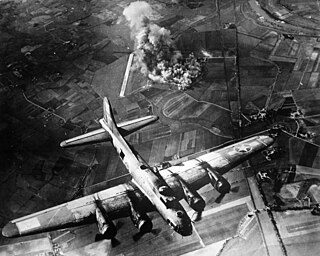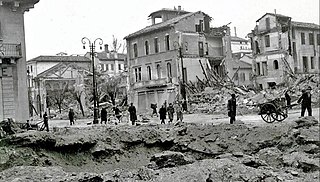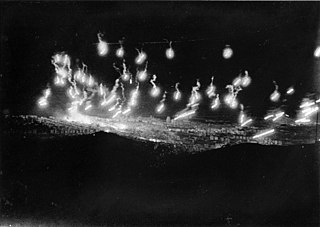
World War II (1939–1945) involved sustained strategic bombing of railways, harbours, cities, workers' and civilian housing, and industrial districts in enemy territory. Strategic bombing as a military strategy is distinct both from close air support of ground forces and from tactical air power. During World War II, many military strategists of air power believed that air forces could win major victories by attacking industrial and political infrastructure, rather than purely military targets. Strategic bombing often involved bombing areas inhabited by civilians, and some campaigns were deliberately designed to target civilian populations in order to terrorize them and disrupt their usual activities. International law at the outset of World War II did not specifically forbid the aerial bombardment of cities – despite the prior occurrence of such bombing during World War I (1914–1918), the Spanish Civil War (1936–1939), and the Second Sino-Japanese War (1937–1945).

Royal Air Force Grafton Underwood or more simply RAF Grafton Underwood is a former Royal Air Force station located 4 miles (6.4 km) northeast of Kettering, Northamptonshire, England.
Innsbruck, an Austrian city, was annexed by Nazi Germany in 1938. It was bombed 22 times by the Allies in World War II, suffering heavy damage.

The bombing of Rome in World War II took place on several occasions in 1943 and 1944, primarily by Allied and to a smaller degree by Axis aircraft, before the city was liberated by the Allies on June 4, 1944. Pope Pius XII was initially unsuccessful in attempting to have Rome declared an open city, through negotiations with U.S. President Franklin D. Roosevelt via Archbishop Francis Spellman. Rome was eventually declared an open city on August 14, 1943 by the defending Italian forces.

The Combined Bomber Offensive (CBO) was an Allied offensive of strategic bombing during World War II in Europe. The primary portion of the CBO was directed against Luftwaffe targets which was the highest priority from June 1943 to 1 April 1944. The subsequent highest priority campaigns were against V-weapon installations and petroleum, oil, and lubrication (POL) plants. Additional CBO targets included railyards and other transportation targets, particularly prior to the invasion of Normandy and, along with army equipment, in the final stages of the war in Europe.

During World War II, the city of Lübeck was the first German city to be attacked in substantial numbers by the Royal Air Force. The attack on the night of 28 March 1942 created a firestorm that caused severe damage to the historic centre, with bombs destroying three of the main churches and large parts of the built-up area. It led to the retaliatory "Baedeker" raids on historic British cities.

During World War II, the German city of Heilbronn was bombed numerous times by the British Royal Air Force and the United States Army Air Forces. The largest air-raid occurred on December 4, 1944, but Heilbronn was targeted several times before and after until the end of World War II. Altogether, an estimated 7,000 inhabitants of the city lost their lives during bombings.

The bombing of Treviso, a town in Northeastern Italy, took place on 7 April 1944, during World War II. Aimed at disabling the town's marshalling yard, it resulted in the destruction of most of the town.

As the main economic and industrial center in Italy, and the country's second largest city, Milan was subjected to heavy bombing during World War II, being the most bombed city in Northern Italy and one of the most bombed cities in the country.

The bombing of Ancona was a series of attacks by the United States Air Force on the city of Ancona in the Marche, Italy during World War II. The raids caused heavy civilian casualties and destroyed or damaged nearly 70 % of the city.

The bombing of Pisa took place on 31 August 1943, during World War II. Aimed at disabling the city's marshalling yard, it also resulted in heavy damage to the city itself and civilian casualties.

The bombing of Cagliari was a series of attacks by the United States Army Air Force and the Royal Air Force on the Italian city of Cagliari, the regional capital of Sardinia, during World War II. The raids, aimed at destroying the port facilities and airfields of Cagliari, also resulted in the destruction of most of the city.

The bombing of Vicenza was a series of attacks by the United States Army Air Force and the Royal Air Force on the Italian city of Vicenza, Veneto, during World War II. The purpose of these raids was to disable the city's marshalling yard and airport, but the bombing also caused considerable collateral damage to the city itself.

Owing to its importance as an industrial center, home to Fiat and several other industries engaged in war production, Turin, the regional capital of Piedmont, suffered over a hundred raids by the Allied air forces during World War II; the Piedmontese capital was thus among the most bombed cities in Northern Italy, suffering damage to about 40% of its housing stock, and over 2,000 victims among its population.

During World War II the Italian city of Palermo, the regional capital and largest city of Sicily, was heavily bombed by both the Royal Air Force and the United States Army Air Force.

During World War II the Italian city of Bologna, the regional capital and largest city of Emilia-Romagna, suffered nearly a hundred air raids by the Royal Air Force and the USAAF, mostly aimed at disabling its strategically important marshalling yards, used for the movements of German troops and supplies between Northeastern Italy and central Italy. These raids destroyed or damaged almost half of the city, and caused nearly 2,500 victims among its population.

During World War II, Tuscany, the Italian port city of Livorno was repeatedly bombed by the Allied air forces, suffering about a hundred raids altogether, which resulted in it being among the most war-damaged cities in Italy.

Owing to the importance of its port and industries, the Italian port city of Genoa, the regional capital and largest city of Liguria, was heavily bombarded by both Allied air and naval forces during Second World War, suffering heavy damage.

The bombing of Reggio Calabria was a series of attacks by the United States Army Air Force and the Royal Air Force on the Italian city of Reggio Calabria during World War II. All together, Reggio Calabria suffered 24 air raids, aimed at disabling its port facilities, airfield and marshalling yards, leaving most of the city destroyed or damaged.

The bombing of Padua was a series of attacks by the United States Army Air Force and the Royal Air Force on the Italian city of Padua, Veneto, during World War II. These raids were aimed at disabling Padua's marshalling yard, but also resulted in heavy damage to the city and civilian casualties.



















